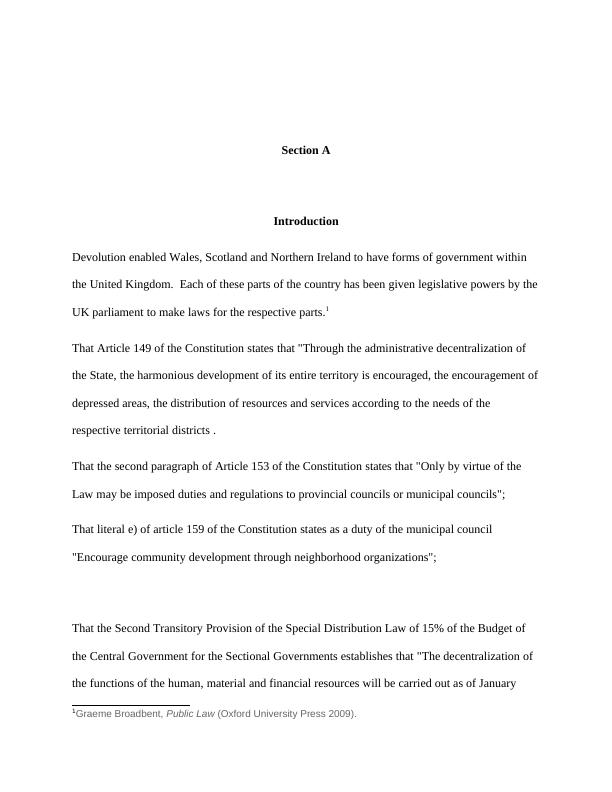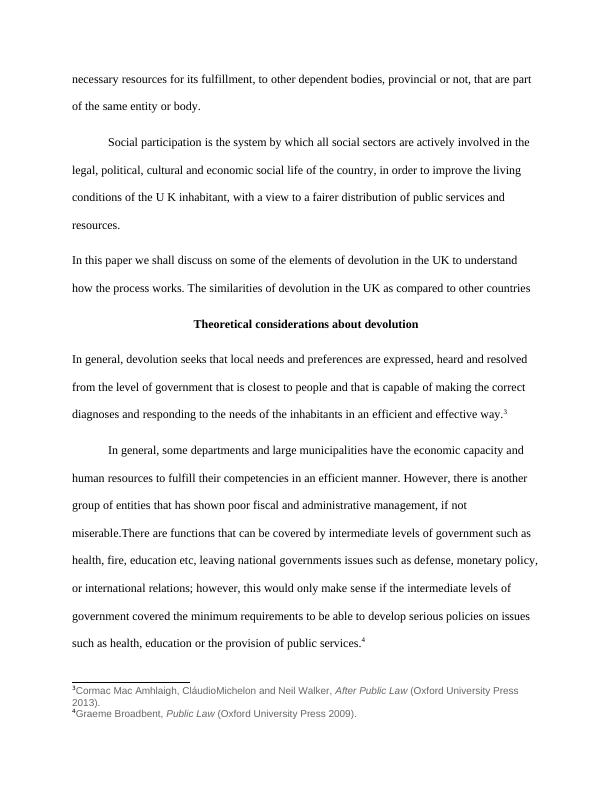Ask a question from expert
International Human Rights Law Assignment
14 Pages3646 Words44 Views
Added on 2020-05-28
International Human Rights Law Assignment
Added on 2020-05-28
BookmarkShareRelated Documents
Public Law
Name:
Date:
Name:
Date:

Section A
Introduction
Devolution enabled Wales, Scotland and Northern Ireland to have forms of government within
the United Kingdom. Each of these parts of the country has been given legislative powers by the
UK parliament to make laws for the respective parts.1
That Article 149 of the Constitution states that "Through the administrative decentralization of
the State, the harmonious development of its entire territory is encouraged, the encouragement of
depressed areas, the distribution of resources and services according to the needs of the
respective territorial districts .
That the second paragraph of Article 153 of the Constitution states that "Only by virtue of the
Law may be imposed duties and regulations to provincial councils or municipal councils";
That literal e) of article 159 of the Constitution states as a duty of the municipal council
"Encourage community development through neighborhood organizations";
That the Second Transitory Provision of the Special Distribution Law of 15% of the Budget of
the Central Government for the Sectional Governments establishes that "The decentralization of
the functions of the human, material and financial resources will be carried out as of January
1Graeme Broadbent, Public Law (Oxford University Press 2009).
Introduction
Devolution enabled Wales, Scotland and Northern Ireland to have forms of government within
the United Kingdom. Each of these parts of the country has been given legislative powers by the
UK parliament to make laws for the respective parts.1
That Article 149 of the Constitution states that "Through the administrative decentralization of
the State, the harmonious development of its entire territory is encouraged, the encouragement of
depressed areas, the distribution of resources and services according to the needs of the
respective territorial districts .
That the second paragraph of Article 153 of the Constitution states that "Only by virtue of the
Law may be imposed duties and regulations to provincial councils or municipal councils";
That literal e) of article 159 of the Constitution states as a duty of the municipal council
"Encourage community development through neighborhood organizations";
That the Second Transitory Provision of the Special Distribution Law of 15% of the Budget of
the Central Government for the Sectional Governments establishes that "The decentralization of
the functions of the human, material and financial resources will be carried out as of January
1Graeme Broadbent, Public Law (Oxford University Press 2009).

1998, of according to the Decentralization Law that will be issued by the Legislative and
Executive functions within a maximum period of 180 days .
Special law of decentralization of the state and of social participation
Art. 1.- Purpose.- The purpose of this Law is to promote the implementation of decentralization
and administrative and financial decentralization of the State, social participation in public
management, as well as to implement the category of decentralized State.
Art. 2.- Scope of application.- The provisions contained in this Law shall apply to entities,
organisms, dependencies of the State and others of the Public Sector; those that make up the
Autonomous Sectional Regime; and, the legal persons created by Law for the exercise of state
authority or for the provision of decentralized public services or to develop economic activities
under State responsibility.2
Art. 3.- Definitions.- The decentralization of the State consists in the definitive transfer of
functions, attributions, responsibilities and resources, especially financial, material and
technological resources of national and foreign origin, of which the entities of the Executive
Function are responsible. Autonomous Sectional Governments for the purpose of distributing
resources and services in accordance with the needs of the respective territorial circumscriptions.
Strength of the devolution system
The deconcentration of the State is the mechanism through which the superior levels of a public
entity or body delegate permanently the exercise of one or more of its attributions as well as the
2Alina Kaczorowska-Ireland, Public International Law (Taylor and Francis 2015).
Executive functions within a maximum period of 180 days .
Special law of decentralization of the state and of social participation
Art. 1.- Purpose.- The purpose of this Law is to promote the implementation of decentralization
and administrative and financial decentralization of the State, social participation in public
management, as well as to implement the category of decentralized State.
Art. 2.- Scope of application.- The provisions contained in this Law shall apply to entities,
organisms, dependencies of the State and others of the Public Sector; those that make up the
Autonomous Sectional Regime; and, the legal persons created by Law for the exercise of state
authority or for the provision of decentralized public services or to develop economic activities
under State responsibility.2
Art. 3.- Definitions.- The decentralization of the State consists in the definitive transfer of
functions, attributions, responsibilities and resources, especially financial, material and
technological resources of national and foreign origin, of which the entities of the Executive
Function are responsible. Autonomous Sectional Governments for the purpose of distributing
resources and services in accordance with the needs of the respective territorial circumscriptions.
Strength of the devolution system
The deconcentration of the State is the mechanism through which the superior levels of a public
entity or body delegate permanently the exercise of one or more of its attributions as well as the
2Alina Kaczorowska-Ireland, Public International Law (Taylor and Francis 2015).

necessary resources for its fulfillment, to other dependent bodies, provincial or not, that are part
of the same entity or body.
Social participation is the system by which all social sectors are actively involved in the
legal, political, cultural and economic social life of the country, in order to improve the living
conditions of the U K inhabitant, with a view to a fairer distribution of public services and
resources.
In this paper we shall discuss on some of the elements of devolution in the UK to understand
how the process works. The similarities of devolution in the UK as compared to other countries
Theoretical considerations about devolution
In general, devolution seeks that local needs and preferences are expressed, heard and resolved
from the level of government that is closest to people and that is capable of making the correct
diagnoses and responding to the needs of the inhabitants in an efficient and effective way.3
In general, some departments and large municipalities have the economic capacity and
human resources to fulfill their competencies in an efficient manner. However, there is another
group of entities that has shown poor fiscal and administrative management, if not
miserable.There are functions that can be covered by intermediate levels of government such as
health, fire, education etc, leaving national governments issues such as defense, monetary policy,
or international relations; however, this would only make sense if the intermediate levels of
government covered the minimum requirements to be able to develop serious policies on issues
such as health, education or the provision of public services.4
3Cormac Mac Amhlaigh, CláudioMichelon and Neil Walker, After Public Law (Oxford University Press
2013).
4Graeme Broadbent, Public Law (Oxford University Press 2009).
of the same entity or body.
Social participation is the system by which all social sectors are actively involved in the
legal, political, cultural and economic social life of the country, in order to improve the living
conditions of the U K inhabitant, with a view to a fairer distribution of public services and
resources.
In this paper we shall discuss on some of the elements of devolution in the UK to understand
how the process works. The similarities of devolution in the UK as compared to other countries
Theoretical considerations about devolution
In general, devolution seeks that local needs and preferences are expressed, heard and resolved
from the level of government that is closest to people and that is capable of making the correct
diagnoses and responding to the needs of the inhabitants in an efficient and effective way.3
In general, some departments and large municipalities have the economic capacity and
human resources to fulfill their competencies in an efficient manner. However, there is another
group of entities that has shown poor fiscal and administrative management, if not
miserable.There are functions that can be covered by intermediate levels of government such as
health, fire, education etc, leaving national governments issues such as defense, monetary policy,
or international relations; however, this would only make sense if the intermediate levels of
government covered the minimum requirements to be able to develop serious policies on issues
such as health, education or the provision of public services.4
3Cormac Mac Amhlaigh, CláudioMichelon and Neil Walker, After Public Law (Oxford University Press
2013).
4Graeme Broadbent, Public Law (Oxford University Press 2009).

End of preview
Want to access all the pages? Upload your documents or become a member.
Related Documents
A Comparative Study of Tax Structure of Indialg...
|2
|1050
|178
Business Function: Types of Organizations, Structures, and Economic Impactslg...
|9
|869
|54